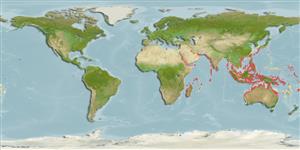>
Eupercaria/misc (Various families in series Eupercaria) >
Gerreidae (Mojarras)
Etymology: Gerres: Latin, gerres = a kind of anchovies; cited by Plinius.
Environment: milieu / climate zone / depth range / distribution range
Ekologi
laut; payau berasosiasi dengan karang; kisaran kedalaman 0 - 20 m (Ref. 11441). Tropical; 36°N - 35°S, 25°E - 174°W
Indo-Pacific: Red Sea to South Africa, east to Marshall and Samoa islands; north to the Ryukyus and south to the Queensland, Australia (Great Barrier Reef) and New Caledonia.
Length at first maturity / Size / Weight / umur
Maturity: Lm ?, range 22 - ? cm
Max length : 30.0 cm TL jantan/; (Ref. 4323); common length : 20.0 cm SL jantan/; (Ref. 37816)
Duri punggung (Keseluruhan (total)) : 9; duri punggung lunak (Keseluruhan (total)) : 10; Duri dubur: 3; Sirip dubur lunak: 7. Body silvery with 6-8 irregular, faint dusky oblique and vertical bands dorsolaterally and ventrolaterally (usually more apparent in young stressed or preserved specimens. U-shaped premaxilla groove mostly without scales (tiny scales anteriorly in specimens over 13 cm SL). Posterior margin of maxillary beyond a vertical through anterior margin of pupil. Supraneural bones 3. Spinous dorsal fin with an indistinct dusky patch (2nd-6th spines) and very narrow dusky distal margins on upper membranes between spines. Scales between 5th dorsal fin spine and lateral line 3-4, usually 3.5. Pelvic fin when fresh is semi-transparent or dull yellow color with an indistinct dusky band and dull white distal margin posteriorly (Ref. 35850); pectoral fins reaches beyond level of anus; caudal fin forked deeply and with long lobes (Ref. 90102).
Found along the coast, saltwater lagoons, and estuaries (Ref. 5213). Also in sand bottoms in sheltered waters near reefs (Ref. 90102). Occurs singly or in groups (Ref. 9710). Feeds on small organisms living on sandy bottoms. Utilized as fish meal and duck food. Sold fresh in markets.
Life cycle and mating behavior
Maturities | Reproduksi, perkembang biakan | Spawnings | Egg(s) | Fecundities | Larva
Iwatsuki, Y., S. Kimura and T. Yoshino, 1999. Redescriptions of Gerres baconensis (Evermann & Seale, 1907), G. equulus Temminck & Schlegel, 1844 and G. oyena (Forsskål, 1775), included in the "G. oyena complex", with notes on other related species (Perciformes: Gerreidae). Ichthyol. Res. 46(4):377-395. (Ref. 35850)
Status IUCN Red List (Ref. 130435)
ancaman kepada manusia
Harmless
penggunaan manusia
Perikanan: komersial
Alat, peralatan
laporan khas
muat turun XML
Sumber internet
Estimates based on models
Preferred temperature (Ref.
123201): 25.2 - 29.3, mean 28.5 °C (based on 3352 cells).
Phylogenetic diversity index (Ref.
82804): PD
50 = 0.5000 [Uniqueness, from 0.5 = low to 2.0 = high].
Bayesian length-weight: a=0.01096 (0.00698 - 0.01722), b=3.09 (2.96 - 3.22), in cm total length, based on LWR estimates for this species & Genus-body shape (Ref.
93245).
Trophic level (Ref.
69278): 2.7 ±0.24 se; based on food items.
Generation time: 1.0 ( na - na) years. Estimated as median ln(3)/K based on 1
growth studies.
Daya lenting (Ref.
120179): Tinggi, Waktu penggandaan populasi minimum kurang dari 15 bulan (Preliminary K or Fecundity.).
Prior r = 1.19, 95% CL = 0.79 - 1.79, Based on 1 data-limited stock assessment.
Fishing Vulnerability (Ref.
59153): Low vulnerability (20 of 100).
Climate Vulnerability (Ref.
125649): High vulnerability (63 of 100).
Nutrients (Ref.
124155): Calcium = 85.5 [43.0, 156.5] mg/100g; Iron = 0.796 [0.382, 1.420] mg/100g; Protein = 19.4 [17.4, 21.4] %; Omega3 = 0.135 [0.074, 0.243] g/100g; Selenium = 32.4 [17.9, 64.0] μg/100g; VitaminA = 38 [10, 133] μg/100g; Zinc = 1.87 [1.23, 2.68] mg/100g (wet weight);
